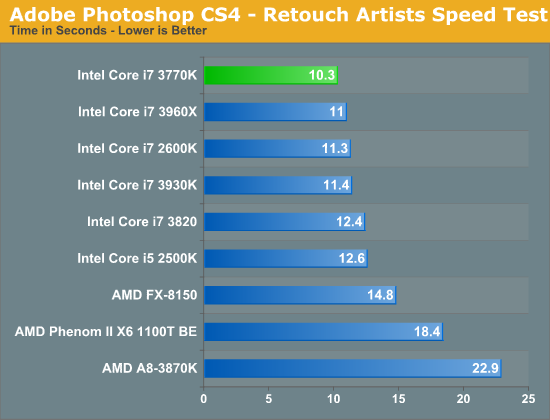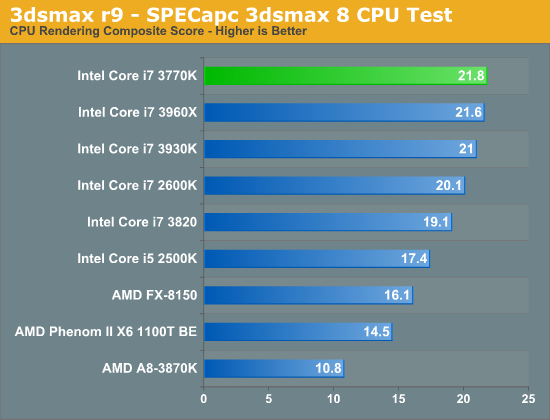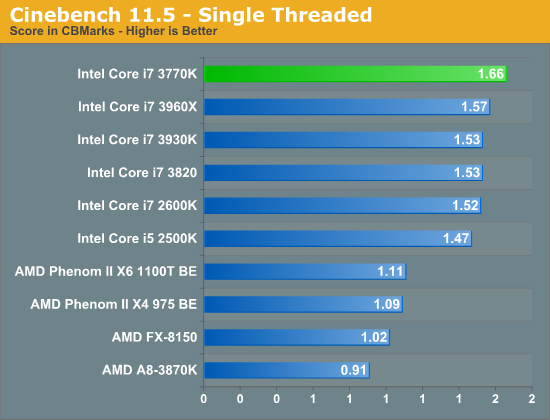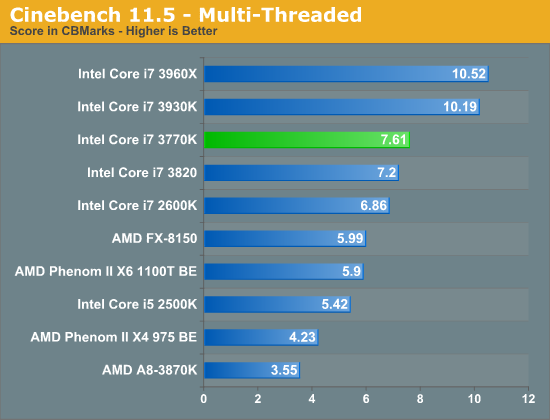The Ivy Bridge Preview: Core i7 3770K Tested
by Anand Lal Shimpi on March 6, 2012 8:16 PM EST- Posted in
- CPUs
- Intel
- Core i7
- Ivy Bridge
Content Creation Performance
Adobe Photoshop CS4
To measure performance under Photoshop CS4 we turn to the Retouch Artists’ Speed Test. The test does basic photo editing; there are a couple of color space conversions, many layer creations, color curve adjustment, image and canvas size adjustment, unsharp mask, and finally a gaussian blur performed on the entire image.
The whole process is timed and thanks to the use of Intel's X25-M SSD as our test bed hard drive, performance is far more predictable than back when we used to test on mechanical disks.
Time is reported in seconds and the lower numbers mean better performance. The test is multithreaded and can hit all four cores in a quad-core machine.

Our Photoshop test is well threaded but it doesn't peg all cores constantly. Instead you get burstier behavior. With the core count advantage out of the way, SNB-E steps aside and allows the 3770K to step up as the fastest CPU we've tested here. The performance advantage over the 2600K is around 9%.
3dsmax 9
Today's desktop processors are more than fast enough to do professional level 3D rendering at home. To look at performance under 3dsmax we ran the SPECapc 3dsmax 8 benchmark (only the CPU rendering tests) under 3dsmax 9 SP1. The results reported are the rendering composite scores.

In another FP heavy workload we see a pretty reasonable gain for Ivy Bridge: 8.5% over a 2600K. This isn't enough to make you want to abandon your Sandy Bridge, but it's a good step forward for a tick.
Cinebench 11.5
Created by the Cinema 4D folks we have Cinebench, a popular 3D rendering benchmark that gives us both single and multi-threaded 3D rendering results.

The single threaded Cinebench test shows a 9% performance advantage for the 3770K over the 2600K. The gap increases slightly to 11% as we look at the multithreaded results:

If you're running a workload that can really stress multiple cores, the 6-core Sandy Bridge E parts will remain unstoppable but in the quad-core world, Ivy Bridge leads the pack.










195 Comments
View All Comments
sabot00 - Tuesday, March 6, 2012 - link
How long will Intel keep its HD Graphics increases?MonkeyPaw - Tuesday, March 6, 2012 - link
I don't understand the logic of selling a high end CPU with the best IGP. Seems like anyone running an it isn't going to stick with the IGP for games, and if they aren't gaming, then what good is that high-end GPU? Maybe the entire "Core i" line should use the HD 4000.Flunk - Tuesday, March 6, 2012 - link
Because the low end chips are just die-harvested high end chips it makes sense. No reason to disable it so they leave it on.And some people do actually use high end processors with IGPs. It's fairly easy to get one from a major OEM. It's stupid but most people don't know any better.
aahkam - Tuesday, March 27, 2012 - link
Funny comments I saw.What's wrong even if the High End CPU that comes with IGP?
Is High End CPU = Gaming Machine CPU? If that is your logic, you're a rich but shallow boy!
I do lots of Video Editing and Transcoding, I need High End CPU but None of the High End GPU beats Quick Sync in Transcoding in terms of Quality and Speed.
dqniel - Friday, April 6, 2012 - link
"and if they aren't gaming, then what good is that high-end GPU?"I feel like you missed that part. He's not saying that only gamers use high-end CPUs. He's saying that gamers using a high-end CPU won't care about the high-end iGPU because they won't use it. Also, non-gamers who need a high-end CPU generally won't see the benefits of the included high-end iGPU. So, he proposes that the better niche for the high-end iGPU would be on the more affordable CPUs, because then budget-minded gamers could buy an affordable CPU that has a relatively powerful iGPU integrated into it.
defter - Wednesday, March 7, 2012 - link
This is a mid-range CPU, not high-end one.High desktop CPUs (i7 3800-3900) don't have IGP.
KoolAidMan1 - Wednesday, March 7, 2012 - link
It is because laptops continue to get slimmer and slimmer. Getting good GPU performance without the compromises on the chassis that a dedicated GPU would force is the point.Tormeh - Wednesday, March 7, 2012 - link
This.My next laptop will have processor graphics for the sake of battery life and size, and whoever has the best graphics gets my money.
bznotins - Wednesday, March 7, 2012 - link
Seconded.aguilpa1 - Wednesday, March 7, 2012 - link
If the 4000HD is on the level of lets say a 560m I would not hesitate to get a laptop with no dedicated graphics but if it isn't I'm still going to go for the dedicated.